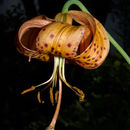en
names in breadcrumbs


Farwell’s proposed varieties uniflorum and umbelliferum were described from young plants with single flowers and umbellate inflorescences respectively, but young plants with these characteristics are found throughout the range of this species. Plants examined from east-central Tennessee (e.g., Wayne and Coffee counties) that were previously referred to Lilium michiganense are L. superbum in some cases, in others L. canadense perhaps introgressed with L. michiganense. The Michigan lily often co-occurs in tallgrass prairies with Lilium philadelphicum; here as everywhere it usually blooms much later. However, it flowers earlier than L. canadense where their ranges are contiguous in Ohio (E. L. Braun 1967). Lilium michiganense is pollinated primarily by swallowtail butterflies; in the southern part of its range these include the pipevine [Battus philenor (Linnaeus), family Papilionidae]. Great spangled fritillaries [Speyeria cybele (Fabricius), family Nymphalidae] also visit this species and carry its pollen, though it is unlikely that this brushfooted butterfly is a major pollinator.
Lilium michiganense is a species of true lily commonly referred to as the Michigan lily.[2] It is a wildflower present in prairie habitats in the Great Lakes and Upper Mississippi Valley regions of the United States and Canada, from South Dakota through Ontario to New York, south to Georgia and Oklahoma.[3][4]
Growing to 5 ft (1.5 m) tall by 2 ft (0.61 m) broad, Lilium michiganense is a bulbous herbaceous perennial with showy flowers in summer.[5] The flowers are orange with dark brown spots and acutely recurved petals. This plant is widely cultivated as an ornamental.
The Michigan lily is often confused with the Turk's cap lily (Lilium superbum) and with a naturalized Asian "tiger lily" Lilium lancifolium. The leaf arrangement is typically whorled, but sometimes alternate just below the inflorescence and at the very base of stem.[5]
The Michigan lily is an endangered species in the state of New York,[6] where it occurs in Monroe and Jefferson counties.[7] It is listed as threatened in Tennessee.[8]
Lilium michiganense is a species of true lily commonly referred to as the Michigan lily. It is a wildflower present in prairie habitats in the Great Lakes and Upper Mississippi Valley regions of the United States and Canada, from South Dakota through Ontario to New York, south to Georgia and Oklahoma.
Growing to 5 ft (1.5 m) tall by 2 ft (0.61 m) broad, Lilium michiganense is a bulbous herbaceous perennial with showy flowers in summer. The flowers are orange with dark brown spots and acutely recurved petals. This plant is widely cultivated as an ornamental.
The Michigan lily is often confused with the Turk's cap lily (Lilium superbum) and with a naturalized Asian "tiger lily" Lilium lancifolium. The leaf arrangement is typically whorled, but sometimes alternate just below the inflorescence and at the very base of stem.